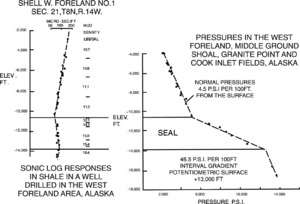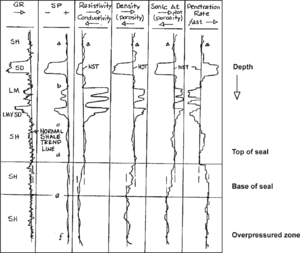Pressure prediction: analysis of well-log and seismic data
| It has been suggested that this article be merged with [[::Pressure prediction|Pressure prediction]]. (Discuss) |
| Exploring for Oil and Gas Traps | |

| |
| Series | Treatise in Petroleum Geology |
|---|---|
| Part | Critical elements of the petroleum system |
| Chapter | Formation fluid pressure and its application |
| Author | Edward A. Beaumont, Forrest Fiedler |
| Link | Web page |
| Store | AAPG Store |
Resistivity, sonic, and density logs (as well as some others) can give clues to the presence of over- or underpressure. Shale sections are best for analysis of logs for abnormal pore pressure. Because of their low permeabilities, shales do not equilibrate pressure with the mud column in the well bore. Selecting only the purest shales minimizes the effects of mineral variation, multiple phases, fluid composition, and fluid distribution. That leaves only porosity as the major variable within shale sections. Because porosity is related to compaction, porosity measurements from well logs can be calibrated to fluid pressure in the pore systems.
Log of drilling rate
Drilling time is useful for detecting abnormal pressure. If the variables are limited (weight on bit, rotary speed, mud properties, pump pressure, and bit type), the major remaining variable that affects rate of penetration in shale is porosity.
Drilling time is kept in real time on every drilling rig. It is often the very first indicator of changing downhole conditions.
Procedure: analyzing well logs
To locate intervals with potentially abnormal fluid pressure, use the following procedure.
- Find the purest shale intervals on the GR or SP base line. They must be reasonably thick to allow valid responses of the other logs and free of sand or lime stringers. (See points a–e, Figure 1.)
- At the same depth, mark the value of resistivity, conductivity, sonic travel time, or density.
- Note any series of these best shale values vs. depth. These define a normal shale trend (NST) line for each of the log curves to be used.
Note: Departure from the NST line indicates abnormal microporosity due to abnormal pore pressure.
Diagram of log response to overpressure
Figure 1 illustrates how overpressures are interpreted from different types of well logs, as explained in the previous table.
Travel time from sonic logs

In some places, an empirical relation can be established to predict pore pressure from well logs. Figure 2 shows sonic travel time varying with measured pressure.
Synthetic seismograms
Resistivity, sonic, and density logs can be used to construct synthetic seismograms which, in turn, can be used to calibrate and refine seismic profiles. Hence, there is a tie-in with geophysical modeling (directly in the case of sonic–density transforms, indirectly in the case of resistivity transforms).
Seismic velocity
Seismic velocity is a function of the density and strength modulus of the rocks through which the energy passes. Both density and strength are affected by abnormal pore pressure. Seismic profiles that show unusually slow interval velocity may indicate an undercompacted (overpressured) interval. Unusually fast interval velocity, conversely, may indicate overcompaction (underpressure).
Summary of log and seismic responses
The table below summarizes typical responses in “pure” shales when encountering zones of abnormal pressure, relative to normal responses.
| Log type | Overpressure | Underpressure |
|---|---|---|
| Drilling rate | Faster | Slower |
| SP | May shift to negative | May shift to positive |
| Gamma ray | May decrease slightly | May increase slightly |
| Resistivity | Lower | Higher |
| Conductivity | Higher | Lower |
| Density | Lower | Higher |
| Travel time | Slower | Faster |
| Seismic interval velocity | Low | High |
See also
- Abnormal pressure prediction
- Pressure prediction: reconstructing burial history
- Pressure prediction: analysis of mud weights
- Pressure prediction: analysis of cuttings
References
- ↑ Powley, D. E., 1990, Pressures and hydrogeology in petroleum basins: Earth Science Reviews, vol. 29, p. 215–226.
